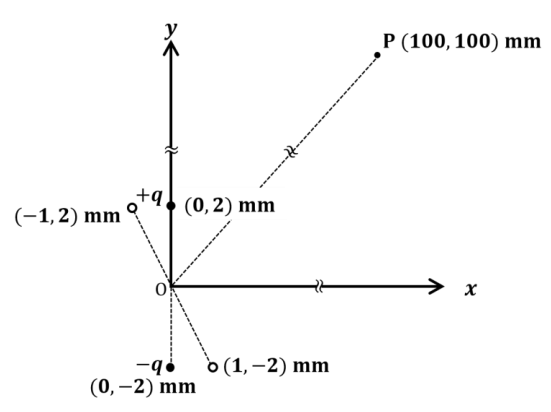Two short dipoles pˆk and P2ˆk are located at (0,0,0) & (1m,0,2m) respectivley. The resultant electric field due to the two dipoles at the point (1m,0,0) is
9p32πε0ˆk
−7p32πε0ˆk
7p32πε0ˆk
None of these
The correct Answer is:B
The given point is at axis of →p2 dipole and at equatorial line of →p dipole so total field at given point is
→E=−k→p(1)3+2k(→p/2)(2)3=k→p(−1+18)=−7→p32πε0
Topper's Solved these Questions
- ELECTROSTATICS AND GAUSS LAWBOOK - NARAYNACHAPTER - ELECTROSTATICS AND GAUSS LAWEXERCISE - Passage I
3 Videos
- ELECTROSTATICS AND GAUSS LAWBOOK - NARAYNACHAPTER - ELECTROSTATICS AND GAUSS LAWEXERCISE - Passage II
3 Videos
- ELECTROSTATICS AND GAUSS LAWBOOK - NARAYNACHAPTER - ELECTROSTATICS AND GAUSS LAWEXERCISE - NCERT based Question
14 Videos
- ELECTROSTATIC POTENTIAL AND CAPACITANCEBOOK - NARAYNACHAPTER - ELECTROSTATIC POTENTIAL AND CAPACITANCEEXERCISE - ADDITIONAL PROBLEMS
14 Videos
- EXPERIMENTAL PHYSICSBOOK - NARAYNACHAPTER - EXPERIMENTAL PHYSICSEXERCISE - Comprehension type
6 Videos
Similar Questions
Two point dipoles pˆk and P2ˆk are located at (0, 0, 0) and (1m, 0, 2m) respectively. Find the resultant electric field due to the two dipoles at the point M(1m, 0, 0)
[−(7P32π∈0)ˆk]
View Solution'Two short dipoles pˆk and p2ˆk are located at (0,0,0) and (1(~m),0,2(~m)), respectively. The resultant electric field due to the two dipoles at the point (1,m,0,0) is 4np32πɛ0k. Find n.
View Solution
Knowledge Check
Two short dipoles pˆk and P2ˆk are located at (0,0,0) & (1m,0,2m) respectively. The resultant electric field due to the two dipoles at the point (1m,0,0) is
A9p32π∈0ˆkB−7p32π∈0ˆkC7p32π∈0ˆkDnone of theseA charge q is placed at (1,2,1) and another charge -q is placed at (0,1,0) such that they form an electric dipole . There exists a uniform electric field →E=(2ˆi+3ˆj). the torque experienced by the dipole is -
Aq(−3ˆi+2ˆj+ˆk)Bq(ˆi+ˆj+ˆk)Cq(3ˆi+ˆj+ˆk)DNone of theseThree point charge q1=1μC,q2=−2μC and q3=3μC are placed at (1m,0,0),(0,2m,0) and (0,0,3m) respectively. Find the electric potential at the origin.
A2.0×103VB9.0×103VC1.0×103VD10×103V
[" Two point dipoles "],[phat k" and "(p)/(2)hat k" are located at "(0,0,],[0)" and "(1m,0,2m)" respectively."],[" if the resultant electric field "],[" due to the two dipoles at the "],[" point "(1m,0,0)" is "x(-(7)/(8)kphat k)" ."],[" Where "k" is electro static "],[" constant.Find "x" ? "]
View SolutionTwo point charges of, 1 μC and -1 μC are kept at (-2 m, 0) and (2 m, 0) respectively. Calculate the electric field at point (0, 5 m).
View Solution4.A electric dipole of dipole moment →p=9ˆi+3ˆj−3ˆk is placed at the point M(2 ,-3 ,1) .If the electric potential due to this dipole at the point B(4 ,-1, 0) is N times 109 volt.Then find N if the given data is in S.l units
View SolutionThe point charges q1=1μC,q2=−2μC and q3=3μC are placed at (1m,0,0),(0,2m,0) and (0,0,3m) respectively. Find the electric potential at origin.
View SolutionAn electric dipole is formed by two charges +q and -q located in xy-plane at (0,2) mm and (0,-2) mm, respectively, as shown in the figure. The electric potential at point P (100,100) mm due to the dipole is V_{0} The charges +q and -q are then moved to the points (-1,2) mm and (1,-2) mm, respectivelyWhat is the value of electric potential at P due to the new dipole?

View Solution
